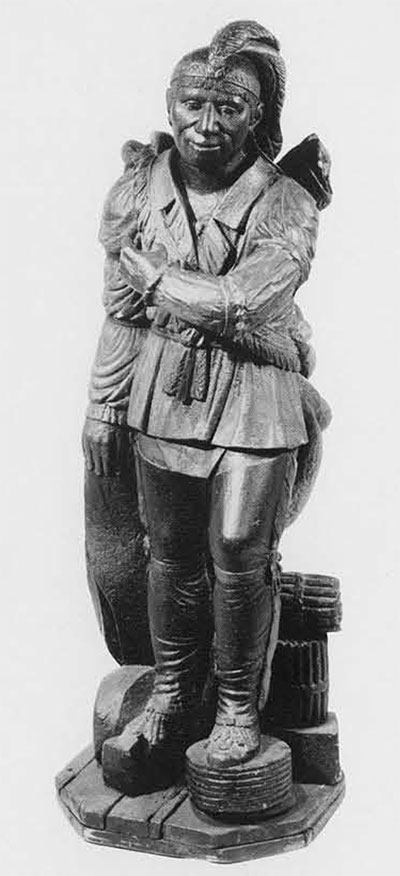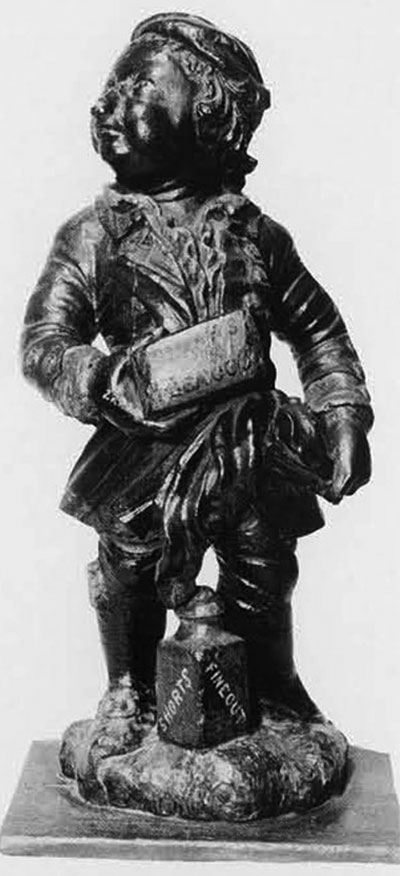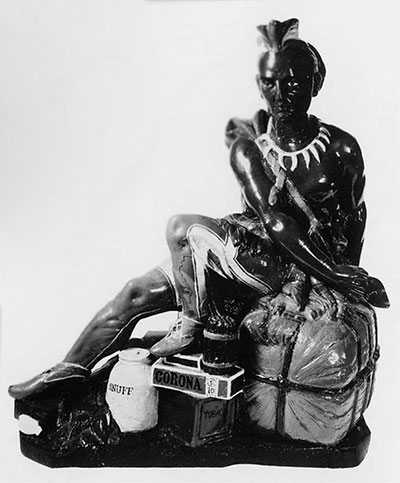
During the summer of 1966 there has been an exhibition at the University Museum of Cigar Store Indians–25 figures borrowed from private collections and museums. Except for the Blackamoor-type figure all of the “Indians” pictured in this article were at the exhibition. With them there has been shown a representative group of American Indian material related to tobacco–pipe bowls and pipe stems, pipe bags and tobacco pouches–from the Museum’s collections.
In writing this account of the “Vanished American” I am particularly indebted to Mrs. E. Florens Rivinus of the Museum’s Women’s Committee who had made a study of the Cigar Store Indians in the Mercer Museum at Doylestown, and who allowed me to use her paper as one of my principal sources. – E.W.R.
Several people are credited with the dubious honor of having first introduced tobacco to Europe, a plant indigenous to the Western Hemisphere. Referred to as both weed and herb, the plant was not fated to remain undiscovered for long, once the white man began his explorations of the New World. Records show that tobacco was being used by whatever Indians the explorers encountered, in one form or another, in the Bahamas, in Brazil, in Mexico, and along the North Atlantic coast. Columbus observed both smoking (of rolled tobacco) and snuff taking on his first two voyages to the Bahamas and West Indies (1492, 1493-6), and in 1502 Spaniards reported having seen tobacco chewed in South America. Unfortunately they did not take any plants home with them. In 1558 Philip II of Spain sent a physician, Francisco Hernandes, to Mexico to look over saleable products and he did bring back a plant. Meanwhile Frere Andre Thevet, who had gone to Brazil in 1555, published a book in 1558 in which he said he had brought seeds to his garden in Angouleme and was growing tobacco there. Portugal must have had it about the same time because when Jean Nicot was ambassador to Portugal between 1559 and 1561 he sent seeds to his queen, Catherine de Medici of France, and gave his name to the genus Nicotiana of the Nightshade family.
According to William Harrison, chronicler of Elizabeth I, Sir John Hawkins first brought tobacco to England in 1565, but in a later edition of his chronicle it states that Sir Walter Raleigh was the first to bring tobacco into use. In various other accounts, Sir Walter Raleigh, Sir Francis Drake, and Ralph Lane are all credited with having introduced tobacco to England. The explanation is that Ralph Lane, the first governor of Virginia, accompanied Sir Francis on a trip to England in 1586 and was said to have been the first person seen smoking in England. One of them gave a pipe and tobacco to Sir Walter Raleigh (and he was growing it on his estate in Ireland b y the next year). It is said that a servant threw a bucket of water over him (others say it was a mug of ale over Lane, and so on) when he was first seen smoking and that he was last seen smoking on the scaffold in 1618, so Sir Walter should probably get most of the credit–at least for making it fashionable!
The important point for the history of tobacco is not who but how. The continental Europeans were cigar smokers and snuff takers after the Central and South American Indians of their acquaintance, and the English became smokers of clay pipes after the North American Indians whom they encountered.
In 1603 James I anonymously published a Counterblaste to Tobacco, blaming Raleigh as the instigator of “a custom loathsome to the eye, harmful to the braine, dangerous to the lungs, and in the black stinking fume thereof, nearest resembling the horrible stygian smoke of the pit that is bottomless.” This counterblast had an effect opposite to that intended, much as did the report of the Royal Commission on Smoking published in 1962. By 1614 there were an estimated seven thousand tobacco shops in or near London. More credit for Sir Walter Raleigh.
James I was not alone in his attitude towards the “vile barbarous custom”:Pope Innocent XII excommunicated those who took snuff or tobacco in St. Peter’s: at Bern the prohibition of tobacco was incorporated into the Ten Commandments; in Russia the penalty was corporal such as splitting the lips or amputating the nose, while in Turkey the penalty was death! James I’s solution was pecuniary. To raise the duty from 2d. to the astronomical figure of 6s.10d. per lb., but everyone kept right on smoking. No one benefited more than the king himself and in spite of his penalties tobacco became an important part of British economy as well as a mainstay of the British colonies in North America. (By 1615 the gardens, fields, and even streets of Jamestown were said to have been planted with tobacco.)
Because of its sternutatory effects, snuff taking was considered a physic for many diseases and disorders (including cancer), and so tobacco was at first sold in apothecary shops. As the smoking habit caught on, it became a treat instead of a treatment, and tobacco was sold in special shops. A special sign was therefore necessary to inform the non-reading public what was for sale inside. Tobacco, however, was a luxury, and the clientele was limited not necessarily to the men, but to the rich. Just as the apothecary had a jar of colored liquid, the saddler or harness maker a wooden horse, the barber his striped pole, the tobacconist had his wooden figure dressed only in tobacco leaves, holding a plug of tobacco under one arm, a clay pipe or snuff box in his other hand. Thus the ancestor of the American Cigar Store Indian came into existence. The resemblance, however, was hardly one of bloodlines.

The first tobacconists’ trade signs, for they cannot be called Cigar Store Indians at this point, were made in England and Holland; the earliest example recorded is 1617. Some were flat boards carved in profile; others, figures carved in the round. The figure was intended to represent the discoverer of tobacco, but confusion arose over the identity of who discovered it, who cultivated it, and who sold it. Thus this early hybrid was referred to as a Red Indian, a Blackamoor, or a Virginian. As it turned out this creature resembled the West Indian Negro more than anything else, although one description claimed he was a ‘pot-bellied native of Guinea with deformed feet.’ West Indians and Ethiopians were being sold at the time to ladies of fashion for page-boys in their boudoirs, and so the peculiar resemblance. Adding to the confusion were the crown and kilt of tobacco leaves worn by the Blackamoor or Black Boy, as he is now most commonly called, which were painted alternately red, green, and gold, and not unlike feathers. In fact, some of the figures had headdresses of feathers and kilts of tobacco leaves and the difference between them as transposed into painted wood was negligible to the unknowing eye. Furthermore, a coating of tar was added as a preservative to the rest of the body which was therefore obviously black and not red. When tobacconists’ figures became popular in America in the mid-nineteenth century, this type of figure was occasionally copied, but stylistically it had no influence on the American Cigar Store Indian. It was conceived as a smaller figure, seldom being over four feet tall, semi-nude, and in most cases not the work of a folk artist or craftsman, but of a more sophisticated academically trained wood carver.
After it was discovered that tobacco could be successfully grown in Turkey (presumably they stopped cutting off people’s heads for smoking) the European shops which imported Turkish tobacco displayed a formidable wooden Turk, sometimes referred to as the “smoking Moor” or “A-rab Indian,” complete with scimitar and turban. Snuff-taking became popular in England and Scotland at the time of the Restoration (1660) when the Court of Charles II brought back the habit from the continent. The canny Scots developed a personal mill which could grind tobacco into snuff without spilling any of the valuable stuff (and of course it was much more economical to “grind your own”). So the figure of the Scottish Highlander with feathered headgear, kilt of wool, and snuff mull became increasingly popular. It might be interesting to note here that although cigars were smoked in England about the same time as snuff was introduced, the practice did not become generally fashionable until the beginning of the nineteenth century when the British military picked it up in Spain during the Peninsular War (1807-14). By 1825 cigars were more popular than snuff. The cigarette became popular in England on a large scale in mid-century after the Crimean War (1854-56). Chewing tobacco or the “quid” was the sailors’ contribution to the nicotine habit, smoking on board ships having been forbidden by the British Admiralty because of the fire hazard. The figure of Jack Tar was not uncommon outside tobacco shops especially in seacoast towns. All of these were later copied in America.
Little is known about the earliest tobacco store figures in America. An “odd cupid-like” figure of a Pocahontas is said to have stood outside a shop on Hancock Street in Boston as early as 1730; a figure of an elegant colonial gentleman stood outside the tobacco shop of Christopher Demuth in Lancaster, Pennsylvania, when it opened in 1770 and still resides there. A few other figures are recorded in connection with other types of business, but on the whole are few and far between, be they red men, white men, or black men. These earlier figures represent the tradition prevalent in England and Europe ow well-carved, under-lifesize figures, with a certain amount of freedom in the pose that is lacking in many of the nineteenth century Indians. They are, perhaps, characteristic of the pre-Victorian era of the eighteenth and early nineteenth centuries when pipe smoking and snuff taking were as fashionable as powdered wigs and knee breeches.
The American Cigar Store Indian, as best remembered, was not part of the American scene until after the 1840’s. His rise to fame would seem to coincide with the increasing popularity of the cigar and the decreasing demand for ships’ figureheads. Judging from old photographs, tobacco stores became cigar (or segar) stores, and each had its own austere wooden Indian holding high a bundle of cigars. Apart from the idea of having a figure representing tobacco outside one’s shop, the American wooden Indian is as American as his aboriginal counterpart. He would seem to belong to the realm of commercial art and advertising, no longer a trade sign whose purpose was mainly identification He is almost always larger than his predecessors, and he was mass-produced in the sense that the same figure was often copied again and again.

Although the wooden Indian was considered a product of the folk artist and wood carver, rather than the sculptor, he evolved from the best tradition of American wood carvers, the figure-head carvers. Both William Rush and Samuel MacIntire carved figureheads, and Rush is known to have made at least two figures for cigar stores. The heyday of the Cigar Store Indian would also seem to coincide with the establishment of regular service between England and the United States by steam-powered vessels, thus replacing many of the great masted ships and leaving many figurehead carvers unemployed, who were probably quite content to turn their talents to the carving of show figures.
Whether the increased supply of carvers created the demand for figures or the popularity of cigars created affluent shop owners, Indians came to be in such demand that certain stores began selling Indians as a sideline to their tobacco business. The earliest was probably William Demuth & Co. of New York in 1840. A later advertisement (1865) of Demuth & Col., now in the Arents Collections of the New York Public Library, states that they were “constantly manufacturing” wooden show figures “for all classes of business, such as Segar Stores, Wine & Liquors, Druggists, Yankee Notions, Umbrella, Clothing, Tea Stores, Theatres, Gardens, Banks, Insurance Companies, &c.” Although Indians were by far the most common, stores such as Demuth sold a large variety of personalities, mortal and immortal, historical and contemporary, including those already common abroad.
The advertisement implies that Demuth & Co. manufactured these figures on the premises, but most evidence would imply that they obtained them from five or six known figurehead carvers working in the city. Samuel Robb was perhaps the best known; others were Thomas White who worked or Robb, Thomas V. Brooks, Nick Collins, John Cromwell, and Tom Millard. We may know their names but unfortunately we seldom know their individual work as they were not in the habit of signing or marking it. Robb is supposed to have studied at the New York Academy of Design, but the others were probably not professionally trained.
A well known carver who was not a figurehead carver but whose work also goes unknown for the most part, was Julius Theodore Melchers. He came from Westphalia to Detroit with a Beaux Arts background and carved Cigar Store Indians when there was no other work on hand or to keep his apprentices employed. Unlike most other carvers, he is said to have used primary sources for his models. In fact most Cigar Store Indians were carved in cities which had long ago seen the last of the aborigines, a fact which becomes more obvious as one regards these figures in detail.
The passing of the sailing era benefited the Cigar Store Indian era in one more aspect. The masts and spars from dismantled sailing ships, generally of white pine, were the wood from which many of the figures were carved. They were large and well seasoned and so made excellent material for a carving destined to remain outdoors. One account says that the masts would be trailed in the water and towed into port, apparently hardening them to the point of being petrified. This would explain the extreme heaviness of some figures. Undoubtedly it was the figurehead carver who purchased his wood at the water front. Oak, mahogany, and maple were also used. The figures were carved from one piece except for upraised or extended arms which would be carved and joined separately. The carver may have worked on five or six different figures at a time, taking about a week to finish each. In the shops where several men were employed (twenty to thirty in some of the large firms) paper patterns may have been used, but most likely one Indian served as a model for the next, unless one was designed for a special commission. It is not known whether one man carved the same model over and over again or whether there were master carvers who executed the originals, later to be copied by apprentices. Certainly some carvers were more skilled than others.
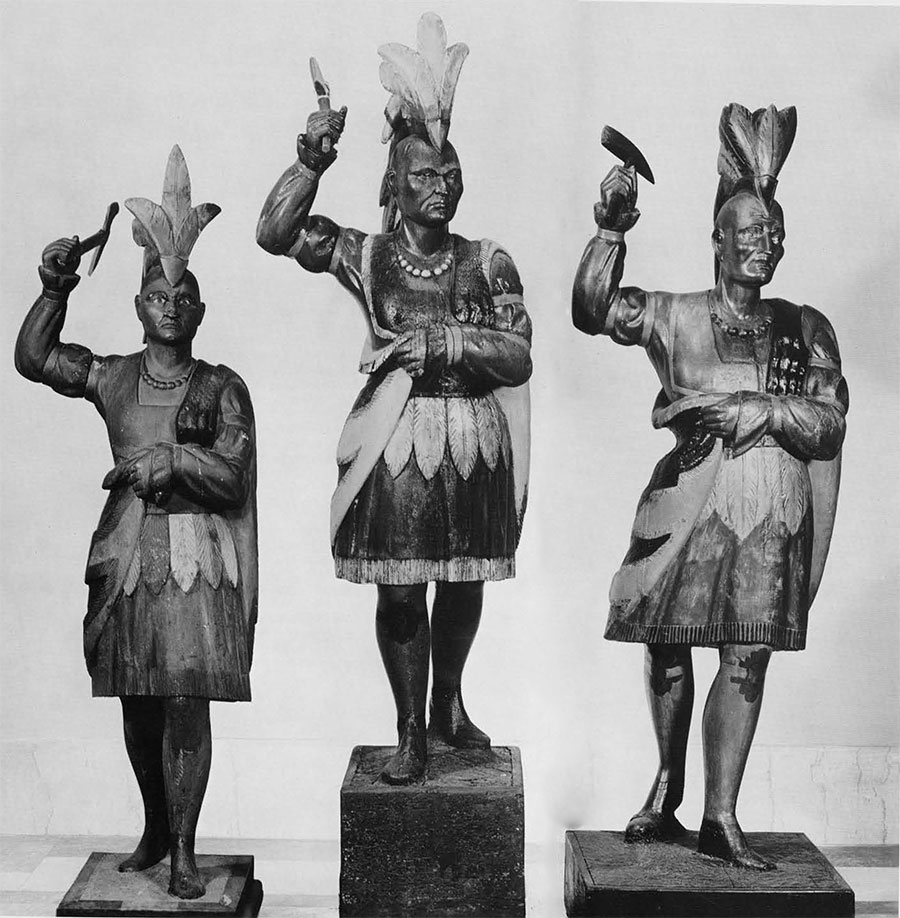
The Indians stood on a base, still part of the same log; then very often were put on wheels for easy movement in and out of the shop. The purpose of the base was to raise a small Indian to better advantage (lots of base and little Indian was also expensive), and to protect them from being knocked over and dented by cart wheels and feet. Most bases have since been replaced.
Although the Indians were usually brought inside the shops at night, time and the elements took their toll, and it was necessary for them to be freshened up every year or two. For a few happy decades a group of itinerant painters were able to make a living doing just that; going from town to town redecorating their clients’ garments and accessories with bright colors of the best paints, including gold and silver, and repainting their bodies a rich chocolate brown. The figures were then lubricated with a gallon or so of linseed oil which could be poured down the backs of their necks, through plugged holes in the tops of their heads.


The production of Cigar Store Indians declined in the 1890’s as a result of the number of cigar stores having reached the saturation point in any given city. Another reason was that existing Indians endured so well it was cheaper to have them repainted and patched than to buy a new one. The rejuvenation and reselling of Indians became a good business toward the end of the era.
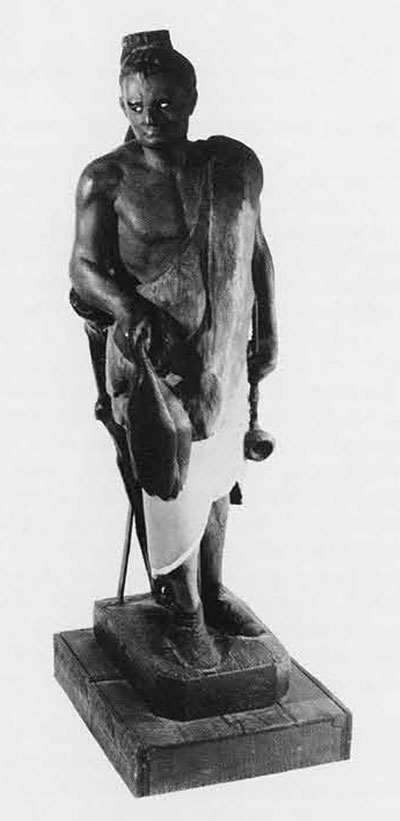
But the very existence of the wooden Indian was doomed. If a new one was considered a waste of money, an old one was just an object of ridicule. Robbed of its nose, its rifle or tomahawk, humiliated by every passing dog, he became an encumbrance, no longer a glowing advertisement. With the advent of chain cigar stores such expensive advertising was unnecessary. Signs were cheaper and the spirit passer-by was less tempted by a sedate sign on the store window or high overhead than by the dignified but defenseless sentinel at the store entrance. The Chicago, Baltimore, and San Francisco fires are blamed for sending the Indians of those cities to the Happy Hunting Ground. In many cities ordinances were passed against sidewalk obstructions, Indians and grocery stands being the greatest offenders. After this humiliation, the brave Indian had no choice but to repair to attics, cellars, and even city dumps. By World War I he had all but disappeared and shortly thereafter he became a collector’s item. There were a few concerned souls at the time who did what they could to protect and collect what came to be known as the Vanishing American, but from an estimate of a hundred thousand at the turn of the century, about two-fifths of the current aboriginal population, the Cigar Story Indian population had dwindled to three thousand by 1950. Nearly five hundred were at one time divided between two collections; they have since been dispersed and are scattered among museums and smaller private collections, while a few have returned to serve their original purpose.
As one might expect, the value of the Indians and show figures has increased in proportion to their decreasing numbers. Fifteen or twenty years ago people were amazed at five hundred dollars for a good redskin; they are now valued in terms of four figures! Originally, one could buy a good Indian from sixteen dollars for a small counter model to $125. or $150. for a large one. A story about a Mr. Caspari of Baltimore attests to the prominence once attained by the Cigar Store Indian. When starting in the tobacco business ( he may have been the oldest tobacconist in Baltimore) he paid thirty dollars for his stock and forty dollars for his Indian. In 1864 he began selling Indians as a sideline and eventually had over a hundred on exhibition, one of which is said to have sold for four hundred dollars.
